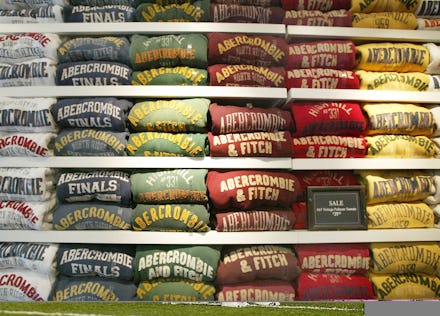Researchers Are Now Able to Measure Just How Embarrassing an Uncool Brand Is

If your high school years were anything like those of your coworkers and friends (and a 2006 Abercrombie & Fitch Co. earnings report suggests they were), the hallways were probably full of T-shirts emblazoned with a preppy moose logo and the initials "A&F." A similar sight were the seagulls from Hollister, the surfer-cool brand owned by Abercrombie & Fitch that shares its penchant for overwhelming store fragrance, blasting music and half-naked male employees.
But those days are over, and most 20-somethings, much less members of Gen-Z, wouldn't be caught dead wearing Abercrombie. How bad has it gotten? We can measure it on the scale of "brand embarrassment tendency," or BET.
Everyone knows that gut feeling when a cool brand suddenly becomes embarrassingly uncool. Now, a study in the Journal of Business Research has introduced a system for determining which people are more likely to be embarrassed by brands and which brands are more likely to trigger that shame.
A scale of embarrassing un-coolness: Using responses to surveys conducted in Germany and the United States, two large markets, the researchers came up with a way to measure BET.
A series of nine statements, such as "I feel embarrassed when I believe that others think the worse of me because of the brands I use and wear" and "I do not wear certain brands because my friends do not approve of them," are answered on a five-point scale, where one means you fully disagree and five means you fully agree.
The resulting number represents a brand's embarrassment tendency. The higher the number, the more embarrassing the brand.
In measuring BET for Ed Hardy and Adidas, Ed Hardy ranked as one of the most embarrassing — in a pretest, the median number was 4.51 — while Adidas was one of the least embarrassing — in a pretest, the median was 1.31. Ed Hardy was embarrassing because it was seen as cheap and tacky by some respondents.
While scientific studies looking at consumer embarrassment have tended to focus on general categories of products (for example, how you might hide your embarrassment over buying tampons, condoms or adult diapers), the new study takes a serious look at the effect un-coolness really has.
"What we found is that people change and brands change, so you can have a perfectly legitimate brand which all of a sudden is viewed negatively," researcher Gianfranco Walsh, PhD, a professor of general management and marketing at the Friedrich-Schiller University of Jena in Germany, told Mic.
What causes a company's number to fall or rise? Exactly what you might expect. "Shifting down or up the scale can be triggered by changing trends, fashions and consumer attitudes, or a corporate crisis," he said.
Those last two are likely causes for Abercrombie's downfall. The former CEO made famously negative statements about who should or shouldn't be wearing the brand's clothes, reflecting a retrograde attitude towards inclusivity. And the company's slip from teenage dominance has been widely publicized. The same might be said of American Apparel, whose overly sexual ads and creepy former CEO gave the company a bad rep.
"People buy a brand because it says something about who they are and what they believe in," Deborah MacInnis, PhD, a professor of marketing at the University of Southern California Marshall School of Business, told Mic. "If there's a brand that does something bad, people feel betrayed but also feel that wearing it would signal that they agree with the values of the company."
As for trendiness, it hasn't helped that Abercrombie was logo-heavy to begin with, which has gone decidedly out of style.
"Most customers are no longer comfortable with such an unsubtle way of portraying themselves," Walsh told Mic of clothes with large logos and brand names.
Just think of the BET scale as validation of your instincts about a brand's cool factor — and a legit academic resource that would have been good ammo to show your mom when she insisted you keep wearing that rhinestone Aéropostale T-shirt.